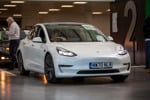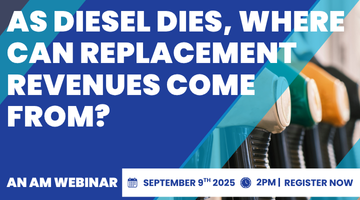The digital journey of Perrys Motor Sales
 Lee Manning, digital marketing manager, Perrys Motor Sales
Lee Manning, digital marketing manager, Perrys Motor Sales
“The single biggest problem in communication is the illusion that it has taken place” – George Bernard Shaw, playwright.
“You’ve got to start with the customer experience and work back toward to the technology” – Steve Jobs, Apple CEO.
Lee Manning shared these quotes at the AM Digital Dealer Conference, as exemplifying the weaknesses in the AM100 dealer group’s former digital offering and the journey it took away from mediocrity.
He summarised the tactic that helped Perrys win the awards for Best Use of TV/Video, Best Social Media Campaign and Digital Initiative of the Year in February’s AM Awards as “bringing the love back” to consumers.
“When I joined Perrys in 2012, the only message we were interested in telling customers was ‘buy a car’,” he said.
Dealership staff told Manning they weren’t getting enough enquiries from its website and it didn’t represent the brand portfolio adequately.
He asked customers what they thought of the site: “They believed we had made it deliberately complicated, made search difficult and they didn’t want to know about ABS, EBS and boot sizes
“ we’d hidden prices because we wanted them to call us to get the information we should be providing without them having to struggle to find it.
“They said ‘talk to me like a human’,” Manning said. As a result, he built a team whose members are titled marketing executives, but are in reality “relationship counsellors” who talk to Perrys’ dealers daily about how they need to adapt to consumer behaviour and to consumers to be clear on what they are missing and putting it right.
“Our industry is primed for disruption and we should’ve acted quicker, shown the love quicker.”
Citing Jobs’s quote, Manning said: “We’re always talking about new features and products, but how often do we stop and ask what consumers need from us?”
One challenge for Perrys was to ensure the amount and detail of information available in a showroom is available online, using consumer feedback to optimise the buying journey, and aiming to find out “what type of consumer are you and how can we take you to the product you want to test drive or buy?”
In practical terms, this included making language simple, images were big and clear, drop-down menus were easy to use and video was incorporated, for example, on whatever platform consumers used to view the site.
Equally important was to ensure staff provided the experience expected by consumers, including sales manager training on social media and where it would take a consumer on the purchasing journey ahead of their arrival in the showroom.
“It’s not true that when they reach the showroom, they are ready to buy,” Manning said. “They could be anywhere on the 24-touchpoint journey Google has identified consumers take in a car purchase. As such we began to ask people where they were on the journey and explain there were ways we could help them.”
Alongside this was the ambition to showcase the Perrys culture and its people and convince consumers it was the right dealer to buy from, ensuring a community of future customers.
Say goodbye to ‘big data’ buzzwords
 Daniel Smulevich, Jellyfish digital analytics manager
Daniel Smulevich, Jellyfish digital analytics manager
Dealers should forget buzzwords such as “big data” and concentrate on the quality of the information they are collecting from customers, said Smulevich.
“One of the most common things I hear from companies is that they have lots of data.
“When you dig a little deeper, it’s clear most companies only have a fraction of the data they claim.”
He said dealers need to start at the very top before setting out their data collection strategy.
Dealers need to ask themselves: What are the business requirements and what problem are you trying to solve? Is it more test drives? Are you just testing a theory?”
He gave as an example a recent campaign that Jellyfish worked on with Motors.co.uk. A pay-per-click campaign with Google was chosen to be optimised for mobile at night at the same time as the company’s television ads would air.
The campaign resulted in a 67% increase in mobile traffic, a 38% reduction in cost-per-click and a 33% reduction in cost-per-lead.
He said companies are now rightly asking what impact digital marketing will have on the bottom line, rather than looking for an arbitrary amount of retweets on Twitter or likes on Facebook.
Smulevich said: “You don’t need large algorithms to wade through the data you have. You just need to understand what structures you have in place, and how the business is using the data at its disposal. With that, a data collection and reporting strategy can be devised to support marketing efforts.
“The trick is to extract and merge information to create a single source of truth, which isn’t as easy as it sounds. Careful planning will net the best results and allow you to uncover the most crucial metrics, which, if implemented, can have the most dramatic effect on business
performance.”
Boost your return on investment in pay-per-click ads
 Ali White, Calltracks marketing and sales director
Ali White, Calltracks marketing and sales director
Dealers need to take a more scientific approach toward how much they are investing in pay-per-click (PPC) advertising, said White.
The majority of the industry’s PPC will be directed through Google’s Adwords, as the company has 88% of the web search market.
“Before you do anything, you need to set objectives,” said White. “You need to act as a bit of scientist and make sure the profit you’re making is covering the investment you’re putting into PPC.”
While Google takes the lion’s share, dealers shouldn’t ignore the recent merger of Bing and Yahoo.
Google Adword campaigns can be exported to Bing’s equivalent fairly easily, according to White, and it can be a cheaper option for PPC as there is less competition.
Dealers should also look at long-tail keywords – three- and four-word phrases that are very specific to whatever a dealer is looking to target – rather than just head terms, popular keywords with high search volumes, such as “Ford Fiesta”.
“You have to figure out whether you can you compete on a head term,” said White. “So many people will be bidding on that and it will be expensive. Long-tail keywords can be highly targeted and offer much better results.”
White urged dealers to explore third-party software to monitor competitors. He suggested using tools such as Spyfu and SEM Rush.
“These web tools can be used to look at what competitors are using as their most profitable keywords.
“It’s possible to use this information to bid against those keywords and mine their hard work and to plan for how much it’s going to cost to outbid rivals.”
White also said it was worth dealers bidding on their own dealership brand name as some competitors are using the trick of placing pay-per-click ads for searches for a local competitor.
Small ways to gain more customers
 Nick King, insight director, Auto Trader
Nick King, insight director, Auto Trader
Dealers can gain customers by optimising websites for mobile, taking younger buyers seriously and making it easier to buy, King told dealers in his masterclass.
He said the mobile web, with a global penetration of more than 80%, must be embraced. Nine out of 10 smartphone users have their device with them 100% of the time and 80% check their phones within 15 minutes of waking, he said.
In a survey where 1,300 consumers shared their experiences of 250 dealers, 58% said they considered multiple marques and a third of 17- to 24-year-olds had no preference of make or model at the outset.
Providing the maximum possible amount of information, including reviews, online is crucial, King said: “Consumers make an average 4.6 website visits before buying a car. When we turn up , we are ready to buy.”
Thus, the off-line experience must match the online perception. Auto Trader’s figures show 58% of car buyers visit the dealership without first making contact, rising to 67% among 17-24-year-olds and among female buyers. The question, according to King, is: “What’s going to make me spend my money with you?”
One in five buyers will visit another dealership if the service is poor, while 76% said they bought their car because they were treated well.
The best experience is had by those spending more than £20,000 on a new car, but millennials (17-34-year-olds) rate their experience the worst, providing an opportunity for dealers especially as this groups is also the most vocal on social media.
Research also shows consumer perception to be worse than reality and by adopting a more transparent approach and a speedier showroom experience, dealers are likely to attract more custom, including the 27% who would buy more often if the process were easier.
“We need to make small changes to make small incremental gains,” he said.
Differentiate with customer experience
 John Miele, director, CarWow
John Miele, director, CarWow
The only way dealers can differentiate themselves is by their customer experience, said Miele.
He said the ‘digital divide’ was a myth, as actually 80% of car buyers visited the dealer to complete the purchase. Consumers buy from another dealer because of pushy sales people (66%); car not available to test drive (33%); no discount offered (31%); poor product knowledge (30%); and too long a wait in the dealership (27%). Some 56% would buy more often if the process were simpler (source: Carwow survey of 1,000 adults).
Of 11,000 Carwow new car sales in 2015, only 25% bought because the dealer was the cheapest. Some 57% decided to buy from the nearest dealer, 31% chose the best rated dealer and 29% had other reasons such as stock availability (some had more than one reason for buying).
Speed of response is crucial – 12% simply called another dealer if they could not be dealt with immediately, while 40% bought from the dealer who was quickest to reply.
“There are several factors dealers can’t change such as the finance campaigns, price and location. The only thing that can change is the customer experience,” said Miele.
The average response time of dealers using its website is 10.3 hours, but the top-performing 5% respond in 1.6 hours. “That’s a big differentiator,” he added.
“It’s not rocket science,” said Miele. “It’s trying to get the training into staff. They are used to a quick response and they are used to transparency.
“We need to make sure we get people through your door and they want to deal with people who give them a fast, friendly response.”
Boosting your online reputation
 Anthony Gaskell, Reputation.com sales director
Anthony Gaskell, Reputation.com sales director
Star ratings can help dealers stand out in search results and adding them is an easy process that can have an immediate impact on click-through rates, Gaskell told delegates.
A dealership needs to have its own Google Business Page in order to attach a star rating to search results.
It needs to get at least five online written reviews from customers with a Google account in order to add the ratings to search results.
Gaskell said: “This is particularly important when looking at local search results because Google recently changed the number of local results from seven to just three.
“They want to make results as specific and accurate as possible for a customer’s current location and having a four- or five-star review next to your link can really help you stand out against the competition.”
A difference of one star in ratings can be worth up to 9% in revenues, according to Gaskell.
He urged dealers to make sure customer testimonials are “front and centre” on dealership home pages.
Gaskell also said monitoring the sheer quantity of online reviews left by customers can be difficult as many dealers are not looking at reviews left outside their own website or Facebook page on business websites such as yell.com.
“Often a company can be discussed on industry-relevant review sites with the business totally unaware of the viewpoints shared and therefore no way of replying or having the opportunity to put anything right.”
Staying in touch with customers
 Ian Godbold, marketing director at Cambria
Ian Godbold, marketing director at Cambria
In a session hosted by Marketing Delivery managing director Jeremy Evans, dealer groups Cambria Automobiles and Swansway Motors revealed how targeted email marketing and cleansing its customer database boosted business.
Godbold said Cambria’s dealerships strove to reply to emails “within minutes”, but then followed up after 24 hours, 72 hours and 14 days.
After analysing the 14-day response rates, he said: “I was shocked at how many consumers made it half-way through their car-buying journey, then suddenly stopped.”
A 14-day contact strategy “helped put Cambria at the front of consumers’ minds”.
Anna Ling, marketing manager at Swansway, said analysis of message content and sending times showed 37% of customers book services as a result of email communication.
Following up on identified amber work with emails resulted in a 23% conversion rate. For customers with telephone data only, the rate is 14%.
Cleansing the group’s 100,000-record customer database and training everyone who uses it boosted turnover by £50,000 in August and increased inbound service bookings by 84% year-on-year.
Evans advised getting in touch with customers earlier than the traditional 28 to 30 days with service reminders.
“When you book a dentist appointment, it’s normal to do it six months ahead.
“Contact customers 60 days ahead of their required service and between a quarter and a third will make a booking before you would have normally reached out to them,” he said.
The changing face of finance online
 James Tew, chief executive, iVendi
James Tew, chief executive, iVendi
The Financial Conduct Authority has done a ‘fantastic’ job of disrupting the market place, said Tew.
“The FCA has been the biggest disruptor to the sector and is making us think differently,” he told delegates.
With 74% of customers researching vehicle funding options before visiting a dealership and more car buyers searching by monthly budget, dealer websites need to contain the finance information to help consumers make decisions.
“Portals will be the key,” said Tew.
However, this has thrown up regulatory issues, as individual quotes have accompanying legalities. Increasing use of mobiles compounds the issue due to space constraints. Tew said his company is liaising with the FCA on the issue.
Given the opportunity, consumers are increasingly using monthly payment criteria to find their next car. The payment search on Motors.co.uk has shown a deposit of £1,000 and a monthly budget of £200 to be the ‘sweet spot’, said Tew.
“They are looking at cars they would not have considered,” said Tew. “It has started to change the whole dynamic of consumer thinking.”
Tew advised dealers to continue to offer several finance products and to use or create a comparison website with a variety of products and rates, but all with the same margin, to make it easy for consumers to choose.
Tew believes ‘self serve’ will allow dealers to reduce their regulatory burden and opt for the new alternative to full authorisation – introducer appointed representative (IAR).
“Self-serve is going to be a big change coming.”
Creating content to meet business objectives
 Justin Kirby, vice-president of content marketing, Tenthwave Digital
Justin Kirby, vice-president of content marketing, Tenthwave Digital
Kirby urged dealers to forget about formats and focus on creating a customer engagement strategy based on content, rather than worrying about a specific social media strategy.
“If you’re thinking about content in specific formats, you’ve already failed.
“Don’t get hung up on whether you’re using YouTube or Facebook, the format is irrelevant. You can use social media as a tool to deliver the content you’re intending, but it’s secondary to figuring out what sort of content you want to produce.”
Kirby said implementing a social media strategy was also a bad path to follow: “What is really needed first is a customer engagement strategy based on content.”
Defining that content can be a bit like “nailing jelly to a table”, but Kirby urged retailers to go beyond the desk and reporting dashboards and really think about authentic, relevant and personal customer experiences.
“There do need to be some universal strategic considerations. Who is this content for?”
Kirby offered some tips for delegates. The first was to create little “hacks” that have a big impact on customer experience. He gave one example of a restaurant chain in the UK that would ask what a booking was for when people would ring or book a table online. Customised menus were then printed with special headings for the occasion, for example “Justin’s birthday”. A second was to look at ways the dealership could create content that might make a customer’s life easier. An example was US DIY company Lowes which introduced its Fix in Six video clips using Vine.
Kirby said: “Looking outside your industry is also essential. Your best experience is your best experience and it doesn’t matter whether that’s in travel or if it happened in a shop, or it happened on a website.
“Continually scan the market for what good content looks like.”
Psychology boosts consumer engagement
 Vesselin Popov, development strategist, The Psychometrics Centre, University of Cambridge
Vesselin Popov, development strategist, The Psychometrics Centre, University of Cambridge
A sophisticated software program that overlays psychological techniques and social media footprints can identify personality traits more accurately than a spouse, Popov told delegates.
Integrating psychology enables businesses to more accurately target consumers by personality as well as by traditional demographics.
“Psychology is another way of understanding customers,” said Popov.
The centre has developed Apply Magic Sauce API, a prediction engine that turns people’s social media activity into accurate psycho-demographic profiles. The ‘myPersonality’ project launched in 2007 and has enabled the university to collate masses of data via social media with more than one million using their app last week alone leading them to discover that the content Facebook users post is indeed very closely aligned with their real lives.
“The computer knows you better than college friends and family using something as innocent as Facebook likes. It is more accurate than humans, even your spouse, at predicting personality.”
Tailoring language to personality types netted results for the Hilton Hotel chain, which created different ads for ‘extroverts’ and those who were ‘highly agreeable’ resulting in a 1,750% increase in click-through rates. Personality-optimised ads performed 17 times better.
Rising sales sees influx of valuation data
 Phillip Nothard, retail and consumer editor, CAP
Phillip Nothard, retail and consumer editor, CAP
Record numbers of new car registrations have meant dealers are facing a glut of data that can make ascertaining a car’s resale value challenging, Nothard told delegates.
“In 2014, we saw the highest number of new car registrations in a decade, and potentially, 2015 is going to see an excess of 2.5 million,” he said.
Nothard said an increase in the number of options and packs on cars has also made vehicle data more complex.
The identification codes that CAP attributes to variations of new cars, which describe engine size, trim, number of doors, body style and fuel type, as well as identifying the make and model of a vehicle, have also seen a strong surge in numbers: “Back in 2005 we had just over 29,000 IDs. Today, it’s just short of 67,000.”
Nothard advised dealerships to look at the data that’s right for them on an individual basis, to help them deal with the sheer volume of data.
“The sales manager doesn’t necessarily need the same amount of data that the CEO needs or the general manager, and he doesn’t need as much as the finance company or the insurance company.
“We all need a slightly different slice of data.”
Search partnership pays off
 David Hart, dealer marketing specialist, Kia Motors UK
David Hart, dealer marketing specialist, Kia Motors UK
Kia has tried to forge a partnership with its network to deliver the best online experience for customers while meeting the needs of both the brand and its dealers, Kia UK’s digital marketing manager Kim Wiggins and dealer marketing specialist David Hart told delegates.
“The challenge for us was how do we come up with a programme which worked for us as a manufacturer, people looking for Kia cars and our dealer network,” said Hart.
For Kia UK, the solution was search and the brand came up with a clear objective two years ago to drive traffic to dealer websites, increase footfall and ultimately sales.
Kia’s initiative between dealers and manufacturer was backed up with Google statistics such as 38% of online research starts with search, 52% of prospective buyers use search to compare options, 35% use search when making their final decision and 51% use mobile to search when at the dealership, (source: Google Motor Insights 2015).
Kia now bids on 2.5 million keywords as part of its search strategy, which appears to be bearing fruit. Traffic is up 104% year-on-year and average cost per click is 71% lower than competitors. Kia also won The Drum Search Award for collaborative search. Kia continues to refine the campaign with its dealers to “close the gap between online and offline”.
“It’s an ever evolving campaign. It’s something that’s not set in stone,” said Wiggins.
Getting the Infrastructure right
 Richard Buxton, head of unified communications, Node4
Richard Buxton, head of unified communications, Node4
Aging infrastructure and multiple services and providers led to Howards Group, a 13-strong multi-brand dealer group in the South West, suffering daily outages and downtime that culminated in an almost catastrophic cyber attack, Buxton told delegates.
Howards faced common issues such as bandwidth restrictions and lack of security, a major problem as many applications are dependent on internet-based solutions.
“The key thing for any network is their connectivity. There’s no point in putting in new technology or throwing money at any application that’s going to sit on top of a network that’s poor.”
Howards hired Node4 in 2013 to upgrade its infrastructure. Improvements included a centralised firewall-protected point for access that connects all Howards’ sites; a central telephone exchange enabling dealerships to contact anyone at any site by using a four-digit extension number; and all Howards equipment was moved into Node4’s data centre. The next phase has been to move some technology into the cloud and Node4 monitors the system enabling them to identify issues as they happen.
“Howards are now in a position where they can evolve; they are not constrained by their current infrastructure, they are agile,” said Buxton.
Peter Haynes, Howards Group group operations, director said: “The problem was future-proofing and scalability. What is appropriate today may not be appropriate in three years’ time. We need something that develops and changes.”
Video through the customer lifecycle
 Alistair Horsburgh, chief executive officer, CitNOW
Alistair Horsburgh, chief executive officer, CitNOW
Dealers are beginning to use video to support PCP renewal business and are encouraging potential customers to send them footage of cars they want a part exchange value on, said Horsburgh.
“The UK market is the most advanced in the world in the use of video by dealers, with 50% of franchised dealers using it to support sales and aftersales,” he said. He predicted that 95% of the UK franchised network would be doing so by the end of 2016.
The latest innovation, he said, was manufacturers using video in the warranty claims process “instead of sending out a claims expert”.
“75% of new cars on average are being sold on PCP and we’re starting to see salespeople choosing to use video instead of phone calls, trying to encourage them to take a test drive,” Horsburgh said.
Dealers are also encouraging customers, who aren’t able to get to a dealership, to take videos themselves to smooth the sales process.
CitNOW provides an app called Trade In that helps a car owner to take and share a video with the dealer “in under three minutes”.
It is being tested with dealers and is “starting to gain traction for dealers wanting to give an indicative valuation and get the consumer into the showroom”.
The most progressive global brand, the leader in video usage, Horsburgh said is Volkswagen. It uses video in 16 areas in sales collectively known as Volkswagen Video Online with retailers able to post their own and receive videos from customers.
“We’re starting to see increased enquiry and conversion rates based on the speed at which you can respond to personalised videos,” said Horsburgh.













Login to comment
Comments
No comments have been made yet.